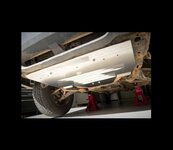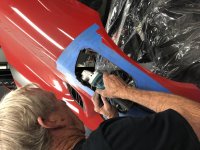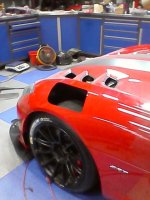You are using an out of date browser. It may not display this or other websites correctly.
You should upgrade or use an alternative browser.
You should upgrade or use an alternative browser.
Internal Body Aerodynamics
- Thread starter vette427sbc
- Start date
69427
The Artist formerly known as Turbo84
- Joined
- Mar 30, 2008
- Messages
- 3,077
- Reaction score
- 38
Regarding Jim's thought on venting the engine compartment with a "boxed radiator" ...
Oddly enough I had two new trucks in my shop with the front grilles removed, both had active aero grille shudders. I didnt have any time to test them electronically, but watching their movement my guess is that they are controlled with stepper motors. Using a engine compartment temp sensor and a vehicle speed sensor, a simple code could be written to control the shudder position. For a full belly pan'd car Im picturing this unit being mounted directly under the engine.
At high speeds, but low load (ie: highway cruising) the vents could be totally closed for max efficiency. As load and heat increase the vents could open at the rear to vent the underhood air. And low speeds (traffic, or low speed autocross maybe?) where the engine compartment temp is high from lack of airflow, the vents could be opened to create a ram-air effect.
Surely this could be implemented anywhere on the car, but this is where my head is at currently :shocking:
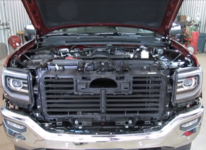
I'm a bit confused here. Are you dumping the "excess/hot engine compartment air under the car?
(Off topic question to you: I'm getting close to opening up/venting the hood at the valley area of the hood scoop. How did you cut that area out without chipping/ripping off chunks of paint? Just taping it first, or what? Thanks.)
69427
The Artist formerly known as Turbo84
- Joined
- Mar 30, 2008
- Messages
- 3,077
- Reaction score
- 38
Or servo motors, if not stepper motors.
Sounds interesting, what makes of trucks?
Probably just need a temp sensor. Probably want to design them to “fail open.”
Didn't Chevy do the same thing on one of their medium/compact cars? I seem to recall reading about that a couple years ago.
vette427sbc
Well-known member
Or servo motors, if not stepper motors.
Sounds interesting, what makes of trucks?
Probably just need a temp sensor. Probably want to design them to “fail open.”
The ones I had in shop were a 16 ram and a 17 sierra. I was thinking the speed sensor might be needed because of the way they vents need to position based on speed... with high temps and high speeds, I would not want the shudders to open for a ram-air effect. The air moving under the car might be enough to draw out the air in the engine compartment with the shudders in "louver position". But at lower speeds like an autocross, there is likely not enough air moving under the car to draw it out, so positioning the shudder for a ram air might be more effective without generating massive lift/drag.
I'm a bit confused here. Are you dumping the "excess/hot engine compartment air under the car?
(Off topic question to you: I'm getting close to opening up/venting the hood at the valley area of the hood scoop. How did you cut that area out without chipping/ripping off chunks of paint? Just taping it first, or what? Thanks.)
Yes and no... At speed, it would be drawn out like the louvers Jim posted:
"Return with us now..."
One way to lower internal drag would be keep the air out of the engine bay. With a "boxed radiator" to improve its flow, vented outside the engine bay, there would still be air from underneath the engine to eliminate. An oversized "Skid Plate" could help - but heat in the bay still a concern.
With louvers, air could be pulled from the bay - at speed, but some fan setup would be needed when stopped. Digital temp gauges are pretty cheap, as are some stainless steel louvers.
....
At lower speeds, fresh air would be pushed into the engine compartment.
I still chipped the paint a bit, I think its inevitable, but an abrasive cutting tool works better than a saw blade with teeth. I used a sharpie to mark my cut, and tape (not on the cut edge) to protect the body from when I slip with the tool. I found that if you cut on the tape it can pull the paint up from the edge when you remove it.
phantomjock
Well-known member
(Off topic question to you: I'm getting close to opening up/venting the hood at the valley area of the hood scoop. How did you cut that area out without chipping/ripping off chunks of paint? Just taping it first, or what? Thanks.)
Maybe use tape and a Dremel/high speed rotary tool? (mini-circ saw.)
Been hanging out at the eco-mod world. They are always trying to get 40+mpg and I want 200+MPH, but same techniques apply.
Here are a couple of ideas I've harvested, that fit this discussion.
https://ecomodder.com/forum/showthread.php/automated-grille-shutters-31585.html
These are "cheap as chips"
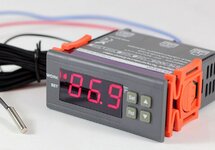
We have a couple on the boat to control fridge/freezer on off. You can adjust setpoint and temperature range. Because they are 12v makes it eazy-peasy too. One more device to set up in the cockpit - but may avoid a trip through the ARDUINO convention. :goodevil:
EBay linkie https://www.ebay.com/itm/DC-12V-F-F...m=141777090187&_trksid=p2047675.c100011.m1850
Here is an implementation one of the guys is working:
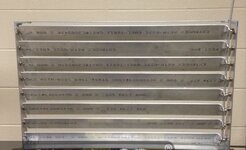 recall about a hundred bucks into it or so. The effort is dated (2015) and no updates - but a good start.
recall about a hundred bucks into it or so. The effort is dated (2015) and no updates - but a good start.Cheers - Jim
phantomjock
Well-known member
Here is another quick link (from 2013) https://www.ecomodder.com/forum/showthread.php/idea-auto-adjusting-grill-block-25096.html
Interesting link using radiator - as well as engine compartment.
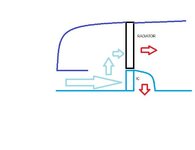
They never produced the results - unfortunately...
Cheers - Jim
Interesting link using radiator - as well as engine compartment.

They never produced the results - unfortunately...
Cheers - Jim
mfain
Well-known member
I'm a bit confused here. Are you dumping the "excess/hot engine compartment air under the car?
(Off topic question to you: I'm getting close to opening up/venting the hood at the valley area of the hood scoop. How did you cut that area out without chipping/ripping off chunks of paint? Just taping it first, or what? Thanks.)
A couple of comments. You don't want to dump air downward out of the engine bay - that causes a high pressure area and kills downforce. Better to vent upward through the hood, or out side vents.
As to cutting a painted surface, I just cut fender air pressure relief holes in a buddy's $20K Viper hood using painters tape and a right angle cut-off wheel. I rounded the corners with a drum wheel (220 grit) and wet sanded all of the edges - no paint chips! The silver car shows the factory cut holes on my ACR. I used it to pull a template from. From a aero perspective, the car normally has louvers in the fender holes, but there is no/very little airflow out of them at speed (verified by yarn tufts). Removing the vents causes a lot of air (and debris off the tires) to be released and the increase in front downforce is quite noticeable. You also get a downforce increase by removing the six plastic grills in the other vent holes in the hood. You can just see some of those vents at the bottom of the silver picture.
Pappy
View attachment 36680View attachment 36681
Attachments
vette427sbc
Well-known member
......
A couple of comments. You don't want to dump air downward out of the engine bay - that causes a high pressure area and kills downforce. Better to vent upward through the hood, or out side vents.
.......
Pappy- My thoughts were that since the engine compartment is essentially sealed, the venting under the car is just to remove heat, not high pressure air. Do you think this is still detrimental to under car airflow? In my own case, Im trying to solve a *potential* underhood heat problem with a solution that is least intrusive visually (hood vents) and has the least aero impact.
mfain
Well-known member
......
A couple of comments. You don't want to dump air downward out of the engine bay - that causes a high pressure area and kills downforce. Better to vent upward through the hood, or out side vents.
.......
Pappy- My thoughts were that since the engine compartment is essentially sealed, the venting under the car is just to remove heat, not high pressure air. Do you think this is still detrimental to under car airflow? In my own case, Im trying to solve a *potential* underhood heat problem with a solution that is least intrusive visually (hood vents) and has the least aero impact.
Here are my thoughts on the potential cooling issue. I am dealing with the same "potential" with a 515 inch big block in my C-1. I went with a wide, double pass Ron Davis radiator. Then I built diffuser duct work from the grill opening to the face of the radiator. This duct work smoothly increases the cross-sectional area as it approaches the face of the radiator, which decreases velocity and increases pressure. Then, after the radiator I used a "chimney" style nozzle that ducts the air upward out vents in the hood. Pretty standard race car stuff. You could open up the fake vents in the C-3's big block hood to keep it from changing the appearance too much. Then I opened up the side vents quite a bit. Actually the 56 didn't have side vents, but I added the vents from a later model C-1 and made them functional to draw air out of the engine bay and out the sides. A long time ago I saw someone selling puller fans for a C-4 than sucked air out of the engine compartment and forced it out the car's side vents.
For the aero question, one of the most effective downforce additions is a good splitter with diffuser tunnels built in the bottom. The splitter pan needs to extend back as far as practical (usually limited by the front suspension). The diffuser tunnels drastically improve the performance of the splitter and they leave low velocity air behind the splitter, which would be negated by dumping radiator air out the bottom of the engine bay.
Pappy
vette427sbc
Well-known member
That is almost exactly my plan, except my side vents are sealed off to provide ducting for my oil and power steering cooler using air fed from the wheel wells... My main concern with the heat is not cooling the engine, its just keeping everything in the engine compartment from seeing 200*+ temps . I was hoping with the active aero shudders underneath the engine I could vent heat when necessary and applicable to what the car is doing.
All of this is just "mental engineering" as I have zero hard data to say I even need to do this, but I like to have some kind of plan in place so I can think about it in the back of my head and tweak it as I get the rest of the vehicle systems in place.
All of this is just "mental engineering" as I have zero hard data to say I even need to do this, but I like to have some kind of plan in place so I can think about it in the back of my head and tweak it as I get the rest of the vehicle systems in place.
phantomjock
Well-known member
Thought I'd post a few pics of the radiator "airbox" I built for Elvira.
First I laid out the frame extensions and fabricated them and welded into place:
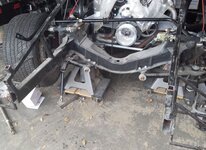
After a bunch of CAD (Cardboard aided design) I gave a mock-up to my sheet-metal man. He did his magic and this was the result:
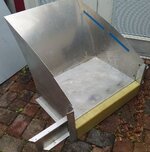
Shown in the photo above are the additional bits I added to support the splitter. The splitter is mounted and shown here:
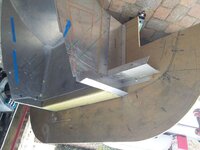
The splitter will be getting some extra work when I start working the 'glass efforts. For example, I may trial either the "fingers" shown a few pages back to make an air curtain,
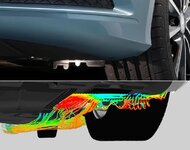
or diffusers incorporated like this:
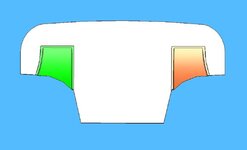
and:
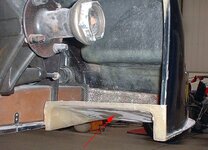
For now the hood just has a HUGE gaping "hole" to dump air - pending testing:
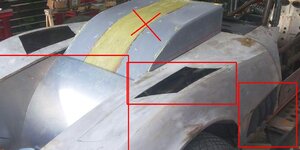
You can see the engine bay is totally isolated from the radiator. The fender louvers are in, and the hood scoop is no longer in play -- too big!
Cheers - Jim
First I laid out the frame extensions and fabricated them and welded into place:

After a bunch of CAD (Cardboard aided design) I gave a mock-up to my sheet-metal man. He did his magic and this was the result:

Shown in the photo above are the additional bits I added to support the splitter. The splitter is mounted and shown here:

The splitter will be getting some extra work when I start working the 'glass efforts. For example, I may trial either the "fingers" shown a few pages back to make an air curtain,

or diffusers incorporated like this:

and:

For now the hood just has a HUGE gaping "hole" to dump air - pending testing:

You can see the engine bay is totally isolated from the radiator. The fender louvers are in, and the hood scoop is no longer in play -- too big!
Cheers - Jim
phantomjock
Well-known member
Radiator Airbox Challenge
One of the big issues for isolating the radiator flow from the engine bay is how big an exit?
This from Katz's fine work:
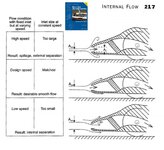
If you flip back to Page 1, Post #6 you'll note how the P-51 Mustang "solved" this issue with the belly mounted cooler. A bit of Arduino code and a data device we could measure the flow and determine how much to open a "flap" to control the stagnation. Or, heck just put up with it. :clobbered:
From the images above - at low speed the stagnation may not be much of a problem - as long as you're getting enough cooling. At high speed (top image) the high pressure build up could be used to advantage with a front mounted splitter.
Cheers - Jim
One of the big issues for isolating the radiator flow from the engine bay is how big an exit?
This from Katz's fine work:

If you flip back to Page 1, Post #6 you'll note how the P-51 Mustang "solved" this issue with the belly mounted cooler. A bit of Arduino code and a data device we could measure the flow and determine how much to open a "flap" to control the stagnation. Or, heck just put up with it. :clobbered:
From the images above - at low speed the stagnation may not be much of a problem - as long as you're getting enough cooling. At high speed (top image) the high pressure build up could be used to advantage with a front mounted splitter.
Cheers - Jim
Last edited:
phantomjock
Well-known member
SIZE - Matters
Well, always looking for the answer; "How big?"
I've found a few rules of thumb for radiator ducts, all located on this convient graphic from the Ultralight Aircraft Community:

When set up, the engineer in me wants to measure the free stream velocity at inlet and exhaust and the pressure "deltas" across the radiator. Ahh, time waits...
Enjoy!
Cheers - Jim
Well, always looking for the answer; "How big?"
I've found a few rules of thumb for radiator ducts, all located on this convient graphic from the Ultralight Aircraft Community:

When set up, the engineer in me wants to measure the free stream velocity at inlet and exhaust and the pressure "deltas" across the radiator. Ahh, time waits...
Enjoy!
Cheers - Jim

